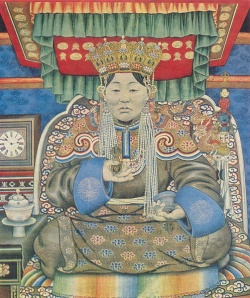Difference between revisions of "Tsendiin Dondogdulam"
| Line 2: | Line 2: | ||
{{see}} [[Buddhism in Mongolia]] | {{see}} [[Buddhism in Mongolia]] | ||
| − | [[Tsendiin Dondogdulam]] (1876–1923) was the [[Wikipedia:Queen consort|queen]] [[consort]] of [[Mongolia]], married to [[Bogd Khan]]. As the [[Ekh Dagina]] ("[[Dakini]] | + | [[Tsendiin Dondogdulam]] (1876–1923) was the [[Wikipedia:Queen consort|queen]] [[consort]] of [[Mongolia]], married to [[Bogd Khan]]. |
| + | |||
| + | As the [[Ekh Dagina]] ("[[Dakini mother]]"), she was believed to be a [[manifestation]] of the [[bodhisattva]] [[White Tara]]. | ||
=={{Wiki|Biography}}== | =={{Wiki|Biography}}== | ||
| − | [[Dondogdulam Tsend]] was born on November 15, 1876 in [[Wikipedia:Khentii Province|Khentii]], [[Mongolia]]. She first met [[Bogd Khan]] in 1895 during his visit to the [[Erdene Zuu Monastery]]. Another [[time]] they met in 1900 during a trip to [[Amarbayasgalant monastery]]. In 1902 they were married and had a son. According to {{Wiki|custom}} she adopted and raised many children from families that could not care for them. One of them was L. Mordorzh who became a prominent [[Wikipedia:Mongolian language|Mongolian]] composer. She and [[Bogd Khan]] also initiated and created the [[Bogd Khan's]] residence that also housed artisans and craftsmen. | + | [[Dondogdulam Tsend]] was born on November 15, 1876 in [[Wikipedia:Khentii Province|Khentii]], [[Mongolia]]. |
| + | |||
| + | She first met [[Bogd Khan]] in 1895 during his visit to the [[Erdene Zuu Monastery]]. | ||
| + | |||
| + | Another [[time]] they met in 1900 during a trip to [[Amarbayasgalant monastery]]. | ||
| + | |||
| + | In 1902 they were married and had a son. | ||
| + | |||
| + | According to {{Wiki|custom}} she adopted and raised many children from families that could not care for them. | ||
| + | |||
| + | One of them was L. Mordorzh who became a prominent [[Wikipedia:Mongolian language|Mongolian]] composer. | ||
| + | |||
| + | She and [[Bogd Khan]] also initiated and created the [[Bogd Khan's]] residence that also housed artisans and craftsmen. | ||
| + | |||
| + | [[Dondogdulam]] [[died]] in 1923 one year before the [[death]] of her spouse. | ||
| + | |||
| + | Day of [[rest]] was observed in the 15th day of the last of month of the autumn. | ||
| − | [[Dondogdulam]] | + | [[Dondogdulam]] was [[Wikipedia:cremation|cremated]] at the source of the Selbe [[river]] near {{Wiki|Ulaanbaatar}}, where at one [[time]] she and her husband spent the summer season. |
Latest revision as of 16:12, 31 January 2016
- See also: Buddhism in Mongolia
Tsendiin Dondogdulam (1876–1923) was the queen consort of Mongolia, married to Bogd Khan.
As the Ekh Dagina ("Dakini mother"), she was believed to be a manifestation of the bodhisattva White Tara.
Biography
Dondogdulam Tsend was born on November 15, 1876 in Khentii, Mongolia.
She first met Bogd Khan in 1895 during his visit to the Erdene Zuu Monastery.
Another time they met in 1900 during a trip to Amarbayasgalant monastery.
In 1902 they were married and had a son.
According to custom she adopted and raised many children from families that could not care for them.
One of them was L. Mordorzh who became a prominent Mongolian composer.
She and Bogd Khan also initiated and created the Bogd Khan's residence that also housed artisans and craftsmen.
Dondogdulam died in 1923 one year before the death of her spouse.
Day of rest was observed in the 15th day of the last of month of the autumn.
Dondogdulam was cremated at the source of the Selbe river near Ulaanbaatar, where at one time she and her husband spent the summer season.
